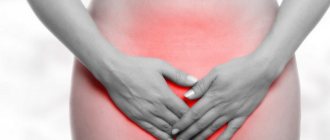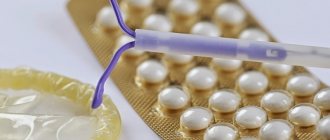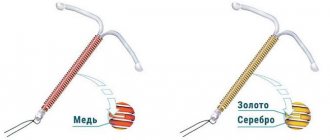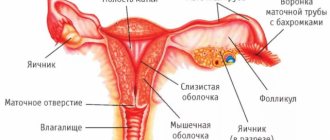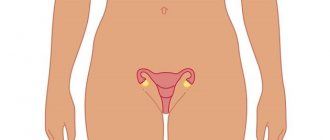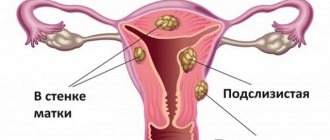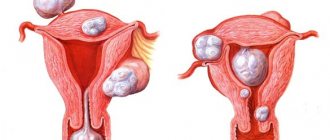The appearance of a child in a family completely changes the life of the parents; all attention shifts to the baby. What kind of mother thinks about herself, because she has a lot of worries! During this exciting, pleasant period, a woman should not forget that her body needs special care.
One of the most pressing problems at this time is protection from pregnancy. Some couples ignore the advice of doctors and resume sexual activity earlier than 4-6 weeks after the birth of the child.
This can lead to a new pregnancy, and the woman, due to the absence of menstruation, will not be aware of this. To avoid an unexpected surprise, it is necessary to resolve the issue of contraception immediately after childbirth.
It is best to consult with your obstetrician on this matter during pregnancy or with a doctor at the maternity hospital. When choosing a contraceptive method, you should not rely only on your own knowledge; only a doctor can choose the optimal method of protection against unplanned pregnancy.
When choosing a method of contraception during the postpartum period, it is important to take into account the fact that the woman is breastfeeding. The chosen method of contraception should not affect lactation. Often when breastfeeding you have to combine different methods of contraception.
During lactation, women can use the following methods of contraception:
- hormone;
- barrier;
- intrauterine device.
The barrier method involves the use of a condom, it is quite effective, but it should be used with caution.
Hormonal contraception should only be prescribed by a doctor, since the drugs should not contain certain types of hormones. Tablets for women who are breastfeeding may contain the hormone progestogen; it does not harm the baby.
The intrauterine device (IUD) does not affect lactation and can be used during the postpartum period.
When can I place an intrauterine device after childbirth?
Not every woman wants to get pregnant again soon after giving birth. Therefore, the issue of contraception when there is a baby in your arms is very relevant. Look around, you will see a lot of mothers with children of the same age. Many of them will tell you that their plans did not include such a rapid addition to the family. But this is what happened: despite breastfeeding, the use of oral contraceptives, strict calculations.
We do not mean to say that birth control pills are not effective, condoms are weak, and breastfeeding does not protect against pregnancy. It’s just that every rule has exceptions, and any woman can make a mistake in the calculations while taking care of the house and baby.
So, let's talk about the most reliable of the modern methods of contraception - the intrauterine device, about when you can install the device after childbirth, what are its advantages, disadvantages, what you should pay attention to.
IUD: what is it, what are the advantages and disadvantages?
The IUD or Intrauterine Device is a mechanical means of protection against unplanned pregnancy. It is installed directly into the uterine cavity and allows a woman, without any additional means of contraception, to quietly engage in sexual activity without becoming pregnant. This is in simple terms.
What are the advantages of this method of contraception? One of the main and most convenient is constant protection. That is, with an IUD installed, you do not need to keep a calendar, take pills strictly on schedule and, thus, there is simply nothing to forget.
Another plus is that the spiral is installed for a long time, or more precisely, for several years. It is during this period that you can absolutely not worry about safety (provided that the IUD is installed correctly). The advantage of this method is its relative cost-effectiveness. At first glance, it may seem that this little thing is quite expensive. However, its price is approximately equal to the cost of an annual set of hormonal pills. Annual! While it is established for a period of up to 5 years.
If you insert an IUD after childbirth, it does not affect the quality and taste of breast milk, and has no effect on the baby’s body if breastfeeding.
And the spiral will come in handy if for some reason hormonal oral contraceptives are contraindicated for you or, say, you have varicose veins, which is quite common today.
The IUD is removed when you need it and the ability to get pregnant after it is restored quite quickly.
The guarantee of not getting pregnant in this case is 99.9%.
Disadvantages, disadvantages, contraindications for installing an IUD
You should not install an intrauterine device if you had inflammatory diseases of the genital organs before or after childbirth. Here you should wait for complete recovery and tissue regeneration. The IUD is inserted and removed only by a doctor. This is the only way you can provide yourself with the desired guarantees of safety and avoid complications later.
The spiral tendrils can sometimes cause some discomfort (often microtrauma) to your sexual partner. Therefore, when installing, you can ask the doctor to make them a little shorter.
After each menstruation, you should check the presence of the antennae, making sure that the spiral remains in place.
Since your body will perceive the IMF as a foreign body, the uterus will try to “expel” it, contracting and giving you unpleasant sensations in the lower abdomen. This can also cause heavier and more painful periods.
IUDs are recommended for women who have one sexual partner to minimize the risk of infections.
If you decide to have an IUD after childbirth, you should be aware that there are certain contraindications.
These include neoplasms (both malignant and benign), pathologies of the uterus, cervix, pregnancy, inflammatory processes, ischemia, uterine bleeding, etc.
There are special contraindications for coils that contain copper: an allergy to this metal. Women suffering from coronary heart disease, migraines, thrombosis, and cirrhosis of the liver are not advised to install a hormonal IUD.
What types of IUDs are there, and why are they placed?
Spirals come in regular and medicated forms.
Conventional ones are made from silver, platinum, gold and polyethylene and are installed solely for the purpose of preventing pregnancy.
Medicines are often given to women, among other things, for therapeutic effects, for example, to treat or control uterine fibroids. They contain copper or the hormone progesterone.
It should be noted that the IUD itself is not a barrier to fertilization of the egg. It is quite possible. However, the IUD thus affects the inner layer of the uterus; the fertilized egg cannot attach to it.
Regular coils need to be removed after a year. IUDs containing copper - after 3-5 years at the discretion of the doctor, and hormonal (with progesterone) - after 5 years (unless, of course, you want to get pregnant earlier).
Is it painful to insert the IUD?
In principle, inserting a spiral does not hurt. It is least painful to install it during menstruation - from 1 to 7 days. However, you may still experience discomfort, as with any gynecological examination. Some women feel nothing at all, while others may experience a slight tugging in the lower abdomen (as during menstruation). As a rule, this goes away within a few hours. Sometimes faster, sometimes a little longer.
The gynecologist will advise you to abstain from sexual activity for the first few days. And before the onset of your period, still use a barrier method of contraception (in other words, a condom).
Immediately after your period, you should come for a follow-up examination and check whether the IUD in the uterus is working properly. If the doctor said that everything is “OK”, you no longer need to use additional means of protection.
When can IUD be inserted after the baby is born?
There are different opinions on this matter. Some gynecologists place the IUD after childbirth right in the maternity hospital. This is only possible if the woman does not experience any inflammatory processes before and after the birth of the child.
Is this advisable or not? Probably, the body still needs rest. After giving birth, you will still be advised to abstain from sexual activity for a while to avoid unnecessary risks of infection. Therefore, if you are very worried and are afraid of becoming a mother again too soon, you can give your internal organs a certain time to recover and have an IUD placed after giving birth in a month and a half.
If the lactation process proceeds without problems, then you can wait six months to install the IUD. However, before inserting the IUD, you should still use a condom during sexual intercourse, since there is still a risk of getting pregnant.
Is it possible to remove the spiral yourself?
We will definitely answer no to this question. The risk of complications (bleeding, infectious diseases, etc.) is too high. Therefore, be wise: do not consider it difficult to see a doctor.
If you have these symptoms, you need a doctor!
- Prolonged nagging pain in the lower abdomen - Chills, fever - Delayed menstruation, obvious signs of pregnancy - Prolonged bleeding - If suddenly you do not find a mustache...
(1 vote(s), result: 5.00 out of 5)
yaposlerodov.ru
Advantages and disadvantages of spirals
The IUD has many advantages and disadvantages to consider.
Advantages:
- it does not affect breastfeeding and the health of the child;
- the protective effect occurs immediately after insertion of the IUD;
- the IUD is installed for a long period after childbirth, therefore, pregnancy will not occur while the IUD is in place (the IUD provides a 99% guarantee that pregnancy will not occur);
- after its removal, fertility is restored very quickly;
- The IUD can be removed at any time;
- no need to worry about protection during sexual intercourse;
- this method of contraception is inexpensive;
- Suitable for women who cannot use hormonal contraceptives.
Flaws:
- Only a doctor can insert and remove an IUD;
- It is not recommended to use an IUD for women who have more than one sexual partner, as the risk of infection increases;
- You should not insert an IUD into women who have suffered from inflammatory diseases after or before childbirth;
- the spiral can cause discomfort in the lower abdomen, which occurs due to contraction of the uterus during breastfeeding;
- several months after the insertion of the IUD, menstruation may be more painful and heavier, the reason for this is the desire of the uterus to reject a foreign object;
- it is necessary to check the antennae of the spiral once a month after menstruation to make sure that it has not fallen out; if the antennae cannot be felt, you need to go to the gynecologist;
- IUDs are not recommended for women with painful or prolonged periods.
Women who have IUDs after childbirth should visit a gynecologist every six months. This is due to the fact that the antennae of the spiral seem to open the entrance to the uterus and infections can enter unhindered.
In order to detect this in time and prevent the development of inflammatory processes in the vagina and cervix, it is necessary to undergo regular examination by a doctor. Do not use the spiral for more than the period indicated on the package. After its administration, you need to see a doctor in a week, then in a month and 3 months.
Your partner should not feel the IUD, however, if he still experiences discomfort, you should consult a doctor to check the correct installation. If the spiral falls out more than twice, it is no longer worth inserting.
When can IUD be inserted after childbirth?
With the advent of a baby, the life of a new mother can be significantly adjusted. All the time is devoted to the child and family, sleepless nights, walks, diapers, feeding, etc. - all this greatly tires a woman, and she simply does not have time to think about herself. And this is very important! After all, after delivery, the mother’s body especially needs care and attention. For example, a woman should consider contraception after giving birth to protect herself from an unplanned pregnancy.
As a rule, most couples, violating medical recommendations, resume intimate life earlier than the recommended period, but the likelihood of getting pregnant during this period is too high. That is why the issue of contraceptives must be resolved immediately after discharge from the hospital, and even better - during pregnancy.
Methods of protection against unplanned pregnancy after childbirth
It is, of course, advisable to discuss the issue of contraceptive methods with your doctor while you are pregnant. If for some reason this did not happen, do not worry, because you can discuss this topic with the doctor at the maternity hospital. In any case, you cannot do without consulting a gynecologist. By choosing contraceptives on your own during breastfeeding, you risk not only your health, but also that of your baby. After all, many of them can negatively affect lactation and, accordingly, the well-being of the baby.
During lactation, a woman is allowed to use the following methods of contraception:
- Barrier, that is, the use of condoms. A classic method of protection against unplanned pregnancy, however, if used incorrectly, it does not provide a 100% guarantee.
- Oral (taking hormonal drugs) - prescribed exclusively by a specialist, since not all existing drugs are approved during pregnancy.
- Insertion of an intrauterine device is the most popular method after delivery. The main advantages of the IUD are safety and long-lasting results (up to 5 years).
Which IUD is better to place after childbirth?
Today there is a wide range of gynecological devices. They differ in quality, shape, composition. The choice largely depends on the cost and, of course, the individual characteristics of the female body.
The rod of the IUD contains active substances, which provide protection against unplanned pregnancy, and thanks to its shape (T-shaped, ring-shaped, etc.), the contraceptive device is held inside the uterine cavity.
So, there are two main types of spirals:
- non-medicinal - made of polyethylene and contain metal (platinum, silver, etc.);
- medicinal (contain copper ions and progesterone) - in addition to the contraceptive effect, they have a positive effect on the ovulatory period, the structure of the endometrium, etc. In addition, such devices are less likely to cause complications and are better fixed in the uterine cavity. However, there is also a minus. Due to the rapid depletion of active components, they must be replaced after 1-3 years.
It is unrealistic to choose the most optimal type of spiral without consulting a doctor. Therefore, if you decide to think about this type of contraception, be sure to consult a gynecologist. Having studied your medical history, the specialist will be able to select the most effective and reliable type of gynecological device.
Features of IUD installation
An intrauterine device is installed or removed only in a clinical setting and only by a gynecologist. Before diagnosis, the patient must undergo examination and tests. Only in the absence of contraindications will the doctor be able to determine the date for inserting the IUD. The procedure is usually performed during menstruation. But since the cycle has not yet been fully restored in new mothers, the installation can be carried out at any time. If the birth took place without complications, then this can happen as early as 6-7 weeks from the moment the baby is born. Otherwise (for example, with a caesarean section), the procedure will have to be postponed for six months.
Installation of the IUD is quick and virtually painless. The shelf life of a gynecological device depends on the quality of manufacture; it can be a year, or maybe eight years. But this does not mean that the spiral needs to be worn as long as indicated in the instructions. If desired, it can be removed ahead of schedule.
In the first days after the procedure, the doctor will definitely recommend abstaining from sexual intercourse and avoiding physical activity, as well as not using tampons and refusing to visit the bathhouse or sauna. In the future, the IUD will not cause discomfort, and the woman can safely return to her usual lifestyle. However, after 10 days, and then again 6 weeks after installation, you must see a doctor to make sure that the spiral is attached correctly and there are no complications. In the future, visits to the doctor should be made regularly - twice a year. However, if alarming symptoms arise (menstruation irregularities, lower abdominal pain, fever, or the IUD threads cannot be felt), immediately go to the gynecologist.
Pros and cons of the IUD
Having discussed the types of IUDs and the principle of their installation, one cannot help but recall the positive and negative aspects of this method. The advantages of the IUD are:
- safety during lactation;
- long shelf life;
- 99% contraceptive effect;
- do not disrupt normal life;
- devices containing progesterone reduce pain and shorten the duration of monthly discharge;
- availability.
The disadvantages of the IUD include:
- discomfort and bleeding for the first two weeks after installation;
- long and heavy periods in the first three months after the procedure;
- the device provides a contraceptive result, but does not protect against infections;
- after the installation of the spiral, sudden changes in mood, skin reactions and decreased sexual desire may be observed.
Despite all the shortcomings, intrauterine devices are considered the most effective and safe method of contraception during the postpartum period. However, do not forget that the effectiveness of their action depends not only on the professionalism of the doctor, but also on an attentive attitude to your health.
beremennost.net
IUD: what is it, what are the advantages and disadvantages?
The IUD or Intrauterine Device is a mechanical means of protection against unplanned pregnancy. It is installed directly into the uterine cavity and allows a woman, without any additional means of contraception, to quietly engage in sexual activity without becoming pregnant. This is in simple terms.
What are the advantages of this method of contraception? One of the main and most convenient is constant protection. That is, with an IUD installed, you do not need to keep a calendar, take pills strictly on schedule and, thus, there is simply nothing to forget.
Another plus is that the spiral is installed for a long time, or more precisely, for several years. It is during this period that you can absolutely not worry about safety (provided that the IUD is installed correctly). The advantage of this method is its relative cost-effectiveness. At first glance, it may seem that this little thing is quite expensive. However, its price is approximately equal to the cost of an annual set of hormonal pills. Annual! While it is established for a period of up to 5 years.
Read also:
Can uterine fibroids decrease in size or disappear completely after childbirth?
If you insert an IUD after childbirth, it does not affect the quality and taste of breast milk, and has no effect on the baby’s body if breastfeeding.
And the spiral will come in handy if for some reason hormonal oral contraceptives are contraindicated for you or, say, you have varicose veins, which is quite common today.
The IUD is removed when you need it and the ability to get pregnant after it is restored quite quickly.
The guarantee of not getting pregnant in this case is 99.9%.
Spiral after childbirth
You are here: Home > Articles > Pregnancy and childbirth > Postpartum period > Spiral after childbirth
The IUD after childbirth is perhaps the last concern of a young mother. There is a lot to do, the baby is constantly crying, the husband demands attention and grumbles, you don’t have time to change pads along with diapers, what spiral? It’s better to just sleep for a minute after giving birth. Half a minute. Can? Nevertheless, sooner or later everyone somehow adapts to the regime of young parents, and having a child is not a reason to exclude the intimate aspect from family life. Therefore, taking care of contraception is important and necessary. It is clear that hormones are excluded, as are suppositories and other vaginal delights. Condoms? Some are suitable, some are not. The IUD after childbirth has been and remains one of the best means of contraception.
Intrauterine device after childbirth - pros and cons
The undoubted advantages of the idea of placing an IUD after childbirth include the following:
- the effectiveness of this method is almost one hundred percent;
- there is no need to think about protection over the next five years;
- A doctor can install the IUD right in the maternity hospital after childbirth;
- does not interfere with lactation;
- does not change hormonal levels and is not felt during sexual intercourse;
- inexpensive.
But, despite the fact that the IUD after childbirth can be considered one of the most affordable means of contraception, there are also disadvantages of this method that should be taken into account:
- does not protect against infections, suitable only for those with a regular partner;
- Only a physician can install an IUD after childbirth;
- there is a possibility of inflammation;
- Menstruation becomes heavier and often more painful.
Which IUD is better after childbirth?
In general, doctors themselves prefer to decide this issue and talk about which IUD is better after childbirth, based on the patient’s parameters. However, a certain awareness on this issue has never bothered anyone. For example, there are only copper coils; it is not recommended to use them after childbirth, as they can cause inflammatory processes. But copper-silver and hormone-free ones are a more suitable option.
After stopping breastfeeding, you can insert an IUD with a hormonal contraceptive, then menstruation will not be as “painful” and long as when installing conventional, non-hormonal models.
When to insert an IUD after childbirth
If the doctor does not see any contraindications, then the IUD can be placed after childbirth right in the maternity hospital. This will not affect the further cleansing of the uterus from blood, mucus and other “elements of pregnancy”. If we are talking about the possibility of installation in the postpartum period, then we should wait until the first menstruation. Usually they come within a few months after birth, less often - within six months. With active breastfeeding, you can wait quite a long time for the arrival of menstruation, since the hormone produced during lactation reliably suppresses ovulation. An intrauterine device is placed after childbirth or during menstruation, at least two months after birth. And after a cesarean section, it can be used no earlier than six months later.
If an IUD is installed after childbirth
Firstly, if the IUD was placed after childbirth, then you should know exactly how long it lasts. How many years can it be worn, but it is advisable that removal occurs a little before the expiration date expires. If for some reason this method of contraception is not suitable, you can remove the IUD at any time, just consult a doctor.
A peculiarity of the introduction of an intrauterine device after childbirth is the complication of bleeding. There may be spotting, heavy periods, or anything else. Therefore, it is important to monitor by the appearance and smell of the discharge whether the inflammatory process has begun. We have already talked about how to distinguish normal discharge from pathology.
It is also completely normal that the spiral is not felt at all by either the woman or her partner. If one of the spouses feels the presence of a spiral, it is necessary to visit a gynecologist and check whether the location of the IUD is disturbed. If the IUD falls out twice after childbirth or changes its position, it can no longer be inserted.
And finally, if you have heard that installing an IUD after childbirth affects libido or sensations during intimate contacts, forget it, it does not and cannot have any effect.
love-mother.ru
When to insert an IUD
Many women are interested in the question: when is the IUD placed after childbirth?
You can insert an IUD immediately after childbirth; this is done by a doctor in the maternity hospital. It is better to place the IUD 6 weeks after the baby is born.
In this case, it is administered during menstruation, from days 1 to 7 of the cycle. During this period, inserting an IUD is the least painful.
If a woman is breastfeeding, an IUD can be inserted six months after giving birth.
When using intrauterine contraceptives, alarming symptoms may appear, such as delayed menstruation, the appearance of signs of pregnancy, cramping or ongoing pain in the lower abdomen with fever or chills, and the absence of spiral threads when palpated. If these symptoms appear, you should immediately consult a doctor.
Spiral after childbirth
After giving birth, a young mother has a lot of worries, and issues of contraception fade into the background. Moreover, even after a natural birth without complications, sexual activity can begin no earlier than after 6-8 weeks. However, it is still worth remembering about the choice of method of protection. Especially if the mother is breastfeeding and cannot use hormonal pills for medical reasons, and barrier methods are not suitable for her for some reason. After all, the natural menstrual cycle can be restored within a few months after childbirth, and, according to WHO recommendations, it is better to plan the next pregnancy no earlier than three years later. Among the methods of contraception that are allowed for young mothers is the intrauterine device.
Benefits of installing an IUD after childbirth:
- high level of efficiency (up to 99% percent);
- long service life (the spiral can be installed for 5-10 years);
- possibility of installation immediately after childbirth in the maternity hospital;
- the ability to use this method of planning when breastfeeding;
- no negative impact on the woman’s body;
- absence of any inconvenience during sexual intercourse for both the woman and the sexual partner;
- affordable cost and ease of installation.
Disadvantages of installing an intrauterine device after childbirth:
- The IUD is an abortifacient contraceptive;
- the IUD does not protect against sexually transmitted diseases, so you must be confident in your partner;
- the spiral must be installed only by a qualified specialist, otherwise there is a risk of complications in the form of inflammation, spasms, and intermenstrual bleeding;
- The intrauterine device has a number of contraindications.
Contraindications to installing an IUD after childbirth and possible complications:
- installation of the IUD may be hampered by problems such as a history of inflammatory diseases, pathologies of the reproductive organs, complications in the postpartum period (before installation, you must undergo a consultation and examination with a gynecologist);
- Possible complications include heavy and painful menstruation in the first months of using the IUD (for young mothers, this can be an exhausting ordeal; if the symptoms do not go away after 2-3 months, you will have to remove the IUD and choose another method of contraception).
When to place the IUD after childbirth?
So, you have weighed all the advantages and disadvantages of this method of family planning and protection from unwanted pregnancy, and have decided to place an intrauterine device after the birth of the child. There are two options: installing the IUD immediately after birth, within 48 hours, or after the end of postpartum discharge, that is, two months after the birth of the baby.
If you want to immediately insert an IUD after childbirth, you must agree with your doctor and purchase the recommended IUD at the pharmacy. If the birth takes place without complications, the doctor will insert an IUD during the next examination in the maternity hospital, and you will be reliably protected from a new pregnancy. If you think about birth control methods only before resuming sexual activity after childbirth, you need to visit a doctor, take a smear, and possibly do an ultrasound of the pelvic organs to rule out diseases and pathologies. After this, if the doctor considers it possible, insert a spiral. After installing the IUD, you must visit your doctor every six months to check your gynecological health and examine the site where the IUD is installed.
An intrauterine device after childbirth can become a reliable method of contraception for a mother if she correctly evaluates all the features of this method and consults a doctor before installation.
Related articles:
| It hurts to have sex after childbirth During childbirth, many women scream that their husbands will no longer wait for sex. Time passes, the baby is born and desire triumphs over promises. However, even here a woman may face trouble in the form of pain. | Disposable panties for women in labor A happy moment of childbirth - and then every minute becomes precious for a woman. Nowadays, it is completely incomprehensible how our grandmothers used to give birth without washing machines, baby monitors and bandages. Today there are many devices that make it easier to care for a child and help his mother. And disposable panties for women in labor are also on this list. |
| Urinary incontinence after childbirth Urinary incontinence after childbirth is common to many women in our age of physical inactivity. But the problem can be solved - the main thing is not to hesitate to consult a doctor to determine the degree of urinary incontinence and the direction of treatment. Or at least read this article to know how to treat this problem. | Discharge from the hospital is always a long-awaited event. Hurry home - and there you can finally feel like a real mother within your own walls! But, if discharge occurs in winter, the young mother is always a little scared - how the baby will cope with the first exit from the room. Read what to do in such cases. |
WomanAdvice.ru
Pros and cons of the intrauterine device
An intrauterine device is, of course, a convenient and reliable method of contraception. But it also has its positive and negative aspects.
Pros:
- Can be used for hepatitis B.
- The ability to conceive is quickly restored.
- There is no need to take hormonal medications and use additional means of protection.
- Does not interfere with the regularity of the menstrual cycle.
- Has a long-term contraceptive effect.
- High level of effectiveness and protection against pregnancy (99-100%).
Minuses:
- Pain in the lower abdomen in the first few weeks after childbirth.
- Heavy periods. In the first 3-4 cycles, menstruation may be painful.
- It is necessary to check the control threads yourself after every menstruation.
- There is a risk of developing inflammatory processes in the pelvic organs. When choosing a high-quality intrauterine system, the risk is reduced.
Is it possible to use an IUD while breastfeeding?
After a baby appears in the house, his mother will have more troubles and responsibilities. It will be especially difficult at first, when the body is recovering after childbirth, there is still not enough strength, knowledge and skills are not enough. And when the rhythm of the new life more or less improves, and sexual activity resumes, the woman begins to think about contraception. After all, after giving birth, you can’t get pregnant a second time right away, and you don’t want to.
Taking care of contraception is necessary and important. Most women prefer reliable and long-term means of protection against unwanted pregnancy. One of these is the intrauterine device (IUD). She has always been and remains a reliable assistant for a woman, allowing her to have an active and regular sex life. So, is it possible to insert an IUD during lactation? What does a woman need to know about this contraceptive and its types?
Advantages and disadvantages of the intrauterine device during lactation
Many women, after the birth of their first baby and before planning their second, use this particular method of contraception. During breastfeeding, the use of an IUD has its own characteristics. The advantages of the product include the following:
- Almost one hundred percent reliability.
- The opportunity not to think about protection for the next five years.
- Installation of the IUD after childbirth is possible right in the maternity hospital.
- The IUD does not interfere with lactation.
- The product is not felt by a woman during sexual intercourse and does not affect her hormonal levels.
- Availability, large selection of IUDs in pharmacies depending on financial capabilities.
Despite the fact that this means of preventing unwanted pregnancy is very popular and reliable, there is also a “other side of the coin”. The disadvantages of the method are:
- Inability to protect against sexually transmitted infections. The spiral is suitable for those women who have a regular sexual partner.
- Existing risk of inflammation and rejection of the IUD.
- Abundance of menstrual flow as a result of the presence of a foreign body in the uterus. In addition, periods become more painful.
About the types of spirals
In most cases, the selection of an IUD is carried out by a gynecologist after examining the patient. The choice of such contraceptives today is large. However, they all have their own characteristics and purpose. So, for example, it is strictly not recommended to install copper coils after childbirth, since they provoke inflammatory processes. A suitable option in the postpartum period would be a copper-silver IUD that does not contain hormones.
After cessation of lactation, you can give preference to a hormonal contraceptive. Its advantage is that periods will not be heavy and painful, as happens when installing non-hormonal models.
When is an IUD placed after childbirth?
If a woman wants it, and the gynecologist does not see any contraindications, then the IUD can be installed right in the maternity hospital. Women in such cases begin to worry about restoring the reproductive system. Will the IUD interfere with this process? No. The product does not affect the cleansing of the uterus from mucus and blood.
If we are talking about installing the product in the postpartum period, then you need to wait until the first full menstruation. This usually occurs within a few months after giving birth. If breastfeeding is active, then you can wait a long time for the arrival of menstruation, since ovulation is reliably suppressed.
You can insert an intrauterine device after childbirth and during menstruation. But after a caesarean section, the procedure is carried out no earlier than 6 months later.
A peculiarity of inserting an IUD after childbirth is the complication of bleeding. The discharge may be spotty. Therefore, it is important to monitor your condition, listen to your sensations, so as not to miss the possible onset of the inflammatory process. After insertion of the IUD, it sometimes falls out. If this happens twice, it means that this contraceptive is not suitable for the woman.
So, in each specific case, a lactating woman should consult with a gynecologist about the appropriateness and timeliness of installing the IUD, as well as choosing its model.
≫ More information on the topic: https://grudnichok.info/story/mozhno-li-stavit-spiral-pri-grudnom-vskarmlivanii
1lustiness.ru
Types of intrauterine devices
The intrauterine device is placed in the uterine cavity; its purpose is to prevent the fertilized egg from entering the uterus. The procedure for its installation can be carried out 6-7 weeks after birth if there is no damage, or six months after a cesarean section.
There are many types of IUDs; their shapes are ring-shaped, T-shaped, with lowered shoulders, etc. The shape of this contraceptive for each woman is selected individually depending on her anatomical features. The contraceptive effect of the IUD is provided by copper ions that are located on its rod.
There are spirals that contain, in addition to copper, propolis or silver. These IUDs cost more and have an additional anti-inflammatory effect. There are also hormone-containing IUDs, their advantage is that menstruation with them is less abundant.
All IUDs are divided into two large types:
- intrauterine - made of polyethylene and metal (silver, platinum, gold);
- medicinal - contain copper (Copper-T 380A, Multiload Cu-375, Nova-T) or progestogen (Mirena).
The first ones need to be changed after a year, the copper ones - after 3-5 years, and the second ones give fewer complications and rarely fall out of the uterus. However, they lose activity more quickly as their active components (copper and progestogen) are depleted.
Gold IUDs are now produced in large quantities, but they are quite expensive. You should decide which IUD is best to install after childbirth only with a gynecologist.
Disadvantages, disadvantages, contraindications for installing an IUD
You should not install an intrauterine device if you had inflammatory diseases of the genital organs before or after childbirth. Here you should wait for complete recovery and tissue regeneration. The IUD is inserted and removed only by a doctor. This is the only way you can provide yourself with the desired guarantees of safety and avoid complications later.
The spiral tendrils can sometimes cause some discomfort (often microtrauma) to your sexual partner. Therefore, when installing, you can ask the doctor to make them a little shorter.
After each menstruation, you should check the presence of the antennae, making sure that the spiral remains in place.
Since your body will perceive the IMF as a foreign body, the uterus will try to “expel” it, contracting and giving you unpleasant sensations in the lower abdomen. This can also cause heavier and more painful periods.
IUDs are recommended for women who have one sexual partner to minimize the risk of infections.
If you decide to have an IUD after childbirth, you should be aware that there are certain contraindications.
These include neoplasms (both malignant and benign), pathologies of the uterus, cervix, pregnancy, inflammatory processes, ischemia, uterine bleeding, etc.
There are special contraindications for coils that contain copper: an allergy to this metal. Women suffering from coronary heart disease, migraines, thrombosis, and cirrhosis of the liver are not advised to install a hormonal IUD.
Read also:
Menstruation and pregnancy – let’s dot the i’s


